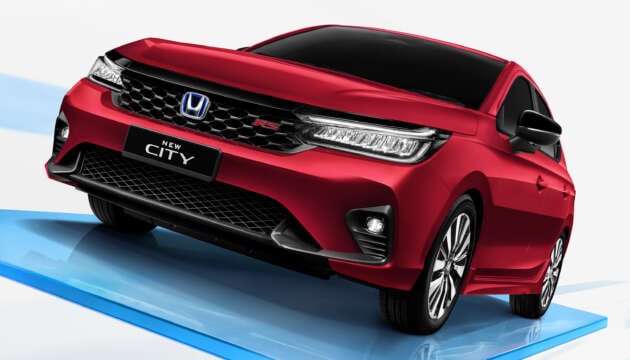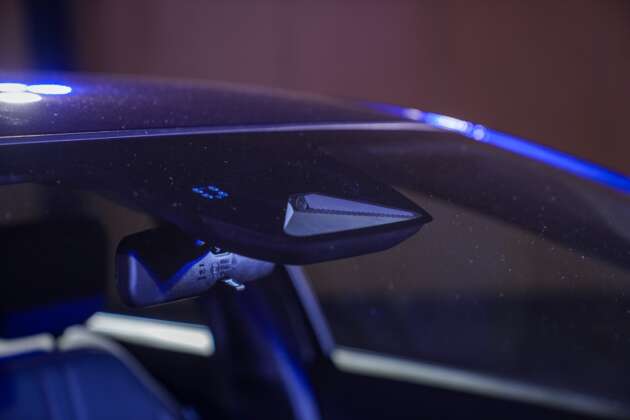
Meanwhile, e:HEV RS features the same Intelligent Multi-Mode Drive (i-MMD) system as before. As such, the front wheels are driven by an electric motor rated at 109 PS (107 hp or 80 kW) and 253 Nm. Power for the electric motor is provided by a lithium-ion battery that is charged by a second electric motor linked to a 1.5 litre naturally-aspirated DOHC i-VTEC four-cylinder engine running on the Atkinson cycle.
The hybrid’s petrol mill is rated at 98 PS (97 hp or 72 kW) and 127 Nm of torque, and while it acts as a generator most of the time, it can clutch in through a single-speed transmission (dubbed E-CVT) to provide direct drive to the wheels at higher speeds where it is most efficient.
It should be noted that the non-hybrid RS variant comes with rear brake discs, which is something the departed V-Sensing didn’t come with. An electronic parking brake remains exclusive to the hybrid e:HEV RS, with other variants receiving a conventional handbrake instead.
As part of the facelift, the City’s grille sports a slimmer chrome bar at the top edge, along with a revised insert featuring black slats. The front bumper is also new with reshaped cutouts for the fog lamp enclosures and a redesigned lower intake with the same insert as the main grille.

For RS models, the chrome bar is finished in black and the grille gets a honeycomb mesh insert. The lower intake is also different as it has a diamond-patterned mesh framed by additional trim simulating air inlets. RS models also come with a rear diffuser-like element, a boot spoiler, side skirts and slightly new ‘RS’ emblems.
With the new front and rear ends, the City is slightly longer overall when compared to the pre-facelift model. Non-RS models now measure 4,580 mm long (+27 mm), while RS models are 4,589 mm (+36 mm), but their width (1,748 mm), height (1,467 mm) and wheelbase (2,600 mm) remain unchanged. Similarly, the non-hybrids maintain their boot capacity of 519 litres, with the hybrid option offering 410 litres instead.
While the exterior is noticeably different from before, the interior remains largely familiar with an unchanged dashboard design. The S and E variants continue to come with a urethane steering wheel and shift knob, along with fabric seat upholstery, while the V and RS cars get leather appointments.
In terms of equipment, we start with the base S variant, which comes standard with 15-inch alloy wheels (185/60 profile tyres), automatic halogen projector headlamps, LED DRLs, keyless entry and start with walk away auto lock, paddle shifters (new for the S), a 4.2-inch multi-info instrument cluster display, manual air-conditioning (with rear vents), one USB port, a multi-angle reverse camera and a standard audio system with Bluetooth and four speakers.

The E variant builds upon the S by adding remote engine start, another front USB port, two rear USB ports, four tweeters, single-zone automatic climate control as well as an eight-inch Display Audio touchscreen head unit that supports wired Android Auto and Apple CarPlay. Stepping up to the V adds on 16-inch alloys (185/55 profile tyres), automatic LED headlamps, front LED fog lamps and the Honda LaneWatch side-view camera system.
Going for the non-hybrid RS nets you a kit list similar to the V, but improved to include a seven-inch digital instrument cluster, sports pedals, Honda Connect telematics as well as support for wireless Android Auto and Apple CarPlay. With the e:HEV RS, you get the RS’ goodies plus auto brake hold thanks to the inclusion of an electronic parking brake.
The range-topper is also the only one that gets an upgraded Honda Sensing suite, which now includes the new Low Speed Follow and Lead Car Departure Notification. The latter, along with Forward Collision Warning, Collision Mitigation Braking System (autonomous emergency braking), Lane Keep Assist System, Road Departure Mitigation, Lane Departure Warning, Adaptive Cruiser Control and Auto High Beam are also now standard for all variants.

Making Honda Sensing standard for all variants is significant, as the suite was previously only offered with V-Sensing and hybrid e:HEV RS. Another safety-related change worth noting is six airbags are now standard across the range (previously only offered from the V onwards). The usual array of passive systems (VSA, ABS, EBD, brake assist, hill start assist, emergency stop signal, and ISOFIX child seat anchors) remain standard on all variants.
The non-hybrid and e:HEV RS variants share three exterior colours, namely Ignite Red Metallic, Meteoroid Gray Metallic and Platinum White Pearl. Customers who go with any of the non-hybrids will also have two addition options: Crystal Black Pearl and Lunar Silver Metallic.
Honda Malaysia also offers a range of optional accessories for the City, including two Modulo packages. The complete package (available for S, E and V variants) adds on an accent garnish for the front lower apron, under spoilers for the front, sides and rear, along with a boot spoiler. There’s also the Modulo 1.0 package (available for all variants) that only includes front and rear under spoilers.

The S, E and V variants can also be optioned with the Urban package that adds door visors, footwell lighting, door sill garnish and sports pedals, the last of which is dropped for the Urban 1.0 package available for all variants.
Another available add-on is the Utility package that includes a car cover, boot tray, boot organiser, door handle covers and reflective film for the door panels. There’s also the Protection package if you need wheel lock nuts as well as window and body coating; a tint film package (Ray Barrier tint from Ecotint); and front and rear dashcams.
A five-year, unlimited-mileage warranty and free labour service (applicable up to five times within 100,000 km or five years) are included with each purchase. The hybrid variant also comes with an eight-year, unlimited-mileage warranty for its lithium-ion battery. Honda Connect is also an option for S, E and V variants.
Looking to sell your car? Sell it with
